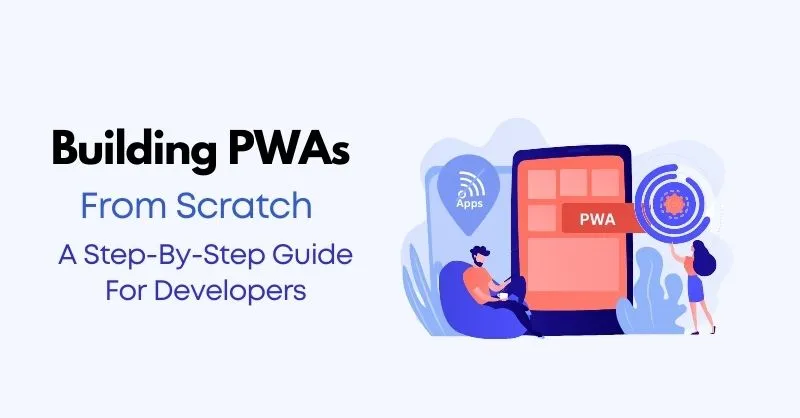Building PWAs (Progressive Web Apps) From Scratch
A Step-By-Step Guide For Developers

Progressive Web Apps (PWAs) have become a ground-breaking way to bridge the gap between web and mobile experiences in today’s quickly changing digital ecosystem. Because PWAs may provide smooth, interesting interactions similar to native mobile apps, both developers and businesses are paying close attention to them. We will examine the complexities of developing Progressive Web Apps (PWAs) in this extensive book, offering a thorough examination of the procedure from conception to implementation.
Whether you’re a seasoned developer looking to broaden your skill set or a novice interested in PWAs, this guide intends to provide you the information and know-how required to start creating high-performance web applications that enthrall users on a variety of platforms and devices. By carefully analyzing industry best practices, useful advice, and real-world examples, we’ll simplify PWA development and provide you the tools you need to produce innovative digital experiences that connect with people all over the world. Together, let’s go out on this adventure to explore the virtually endless potential of Progressive Web Apps.
Recognizing Progressive Web Applications (PWAs)
It’s important to understand the basic ideas underlying Progressive Web Apps (PWAs) and how they differ from regular web apps and native mobile apps before diving into the complexities of PWA development. PWAs give users an app-like experience right out of the web browser by fusing web and mobile technology.
PWAs provide an immersive experience that is similar to native mobile apps by utilizing contemporary web capabilities. Because of the use of service workers, a kind of web technology that permits background synchronization and caching of app resources, PWAs have the unique ability to operate flawlessly offline. Users can access material and functionality even in situations with spotty or nonexistent internet connectivity thanks to this offline functionality.
PWAs also give developers the opportunity to interact with users even when they are not actively using the app thanks to features like push notifications. This capacity to communicate in real-time fosters a more dynamic and interactive user experience by improving user engagement and retention.
The ability to be placed on the home screen of the user’s device, which obfuscates the distinction between web apps and native apps, is another distinguishing feature of PWAs. PWAs can be added to the home screen and started with a single press thanks to the use of web app manifests and service workers, giving consumers rapid and easy access to their favorite apps without the need for traditional app stores.
PWAs are generally made to provide quick, dependable, and interesting user experiences on a range of platforms and devices. PWAs enable developers to create web applications that challenge native mobile apps in terms of feature and performance while maintaining the web’s accessibility and ubiquity. This is achieved by leveraging the power of contemporary web technologies. Comprehending these fundamental ideas is necessary to start a successful PWA development process.
Organizing Your PWA
Establishing the objectives and specifications for your project is the first stage in creating a PWA. Think about things like your intended user base, the function of your app, and the features you wish to incorporate. To comprehend customer wants and preferences and spot market gaps or possibilities, conduct market research. Make a thorough project plan that specifies the resources, timetable, and scope needed for development. Then, set up key performance indicators (KPIs) to gauge how well your PWA is performing.
Organizing Your Workspace for Development
A vital initial step when starting to design a Progressive Web App (PWA) is setting up a stable development environment. .. You may expedite the development process and increase production by making sure you have the required resources and tools on hand. This is a thorough how-to for configuring your development environment for PWA development:
A). Select a Code Editor
Choosing the appropriate code editor is crucial to a productive and seamless working process. To improve your coding workflow, think about utilizing well-known code editors like Atom, Sublime Text, or Visual Studio Code, which provide robust functionality, adaptable user interfaces, and big ecosystems of plugins.
B). Implement Version Control
Version control is essential for maintaining project history, managing code modifications, and encouraging teamwork. Use Git, a popular distributed version control system renowned for its adaptability and durability, to implement version control. Make good use of tools such as GitHub, GitLab, or Bitbucket to host your repositories and facilitate peer collaboration.
C). Install Node.js and npm
Modern online development is impossible without Node.js, a JavaScript runtime environment that lets you run JavaScript code outside of a web browser. Installing, managing, and sharing JavaScript libraries and tools is possible with Node.js’s package manager, npm. Install npm and Node.js by downloading the most recent stable version from the official Node.js website and following your operating system’s installation guidelines.
D). Become acquainted with webpack
Webpack is an effective module bundler and build tool that makes optimising and maintaining web assets for production easier. It enables you to optimize performance and minimize load times by combining CSS, JavaScript, pictures, and other components into a single package. Learn how to use the loaders, plugins, and configuration options available in webpack to improve performance and expedite your PWA development process.
E). Examine PWA-Specific Libraries and Tools
Learn about PWA-specific tools and libraries in addition to the essential web development tools. These can help you design PWAs more quickly and improve their functionality. Examine frameworks such as Angular, Vue.js, or React for creating interactive user interfaces, and libraries such as Workbox for caching strategy management and service worker implementation.
Establishing the Base
Syntax: HTML, CSS, JavaScript The web’s fundamental building blocks, HTML, CSS, and JavaScript, are at the heart of any PWA. Start by defining the layout and content of your application using HTML to create its structure. Use CSS to style your app to improve its usability and appearance while making sure that its design is responsive and mobile-friendly.
JavaScript can be used to give your PWA interactive features and dynamic functionality including offline caching, user authentication, and data fetching.
Putting Progressive Enhancement Into Practice
One of the main tenets of PWA development is progressive improvement, which centers on providing a minimum experience to all users, irrespective of their device or browser capabilities, and gradually improving the experience for users with more sophisticated features. Use feature detection strategies and contemporary web APIs like Web App Manifest, Cache API, and Service Workers to add progressive features to your PWA, like offline support, push notifications, and home screen installation.
Enhancing Accessibility and Performance
When developing a PWA, performance and accessibility are essential components that can have a big impact on user happiness and engagement. Reduce file sizes, minimize resource loading times, and use strategies like code splitting and lazy loading to speed up page loads to maximize the performance of your PWA.
By following online accessibility standards and rules, such as the online Content Accessibility rules (WCAG), and carrying out frequent accessibility audits and testing, you can make sure your PWA is usable by people with disabilities.
Examining Your PWA
In order to make sure your app is dependable, functional, and user-friendly across a variety of platforms and browsers, testing is a crucial step in the PWA development process. Make sure your PWA is fully functional, performant, and compatible by thoroughly testing it with programs like Lighthouse, WebPagetest, and BrowserStack.
To find any usability problems or defects, conduct user testing, collect feedback, and make necessary iterations to your PWA depending on the knowledge you obtain.

Implementing Your PWA
Congratulations on finishing the deployment stage of the development of your Progressive Web App (PWA)! When you deploy a PWA, you have to make it globally accessible by hosting it on a dependable platform and guaranteeing smooth releases and updates. This is a thorough how-to for setting up your PWA
A). Select a Web Hosting Company
Making the correct hosting provider choice is essential to guaranteeing your PWA’s performance, scalability, and dependability. Think about trustworthy hosting services like Firebase, Netlify, or AWS Amplify, which provide dependable infrastructure, flexibility in deployment, and compatibility with contemporary web technologies. Prior to deciding, consider aspects like cost, scalability, security features, and support available.
B). Set Up Your PWA for Rollout
Make sure your PWA is set up to provide the greatest user experience and is optimized for production before releasing it. Optimize your HTML, CSS, JavaScript, and image assets by minifying and bundling them to speed up load times. Adopt best practices for responsive design, offline support, and caching to guarantee cross-device and cross-network compatibility. Before deploying, extensively test your PWA across a variety of browsers and devices to find and fix any compatibility issues.
C). Establish Pipelines for Continuous Integration and Deployment (CI/CD)
By automating the deployment process with CI/CD pipelines, you can safely and efficiently provide changes and releases to your PWA. To automatically launch builds, tests, and deploys whenever changes are posted to your repository, integrate your version control system (such as Git) with continuous integration and deployment (CI/CD) systems like GitHub Actions, GitLab CI/CD, or CircleCI. Before deploying, set up deployment pipelines to execute performance, integration, and unit tests to make sure your PWA is stable and of high quality.
D). Keep an eye on usage and performance metrics
After your PWA is live, use analytics software like Google Analytics or Firebase Analytics to track its usage and performance data. Monitor important performance indicators like page load speeds, conversion rates, user engagement, and retention to learn more about how users engage with your PWA and pinpoint areas that need work. To get user input and iterate your app based on their preferences and behavior, employ A/B testing and user feedback tools.
E). Recreate and Enhance
Your PWA’s lifespan doesn’t end with deployment. Iterate and enhance your software frequently depending on user input, data insights, and changing industry trends. Provide updates, new features, and improvements on a regular basis to keep your PWA competitive in the ever-evolving digital market and fresh. Develop a devoted user base and encourage PWA adoption by interacting with users on social media, in support forums, and through feedback channels.
At Last
Developing Progressive Web Apps (PWAs) from the ground up offers developers a tremendous chance to create remarkable digital experiences that are fast, dependable, and engaging. Through adherence to the detailed, step-by-step instructions outlined in this blog, developers can fully utilize state-of-the-art web technologies to produce PWAs that are competitive with native mobile applications. To ensure the success and competitiveness of your PWA in today’s changing digital market, it is essential to embrace important principles including performance optimization, progressive enhancement, and user-centric design, whether you are developing a new PWA or improving an existing web app.
PWAs, in short, have completely changed the way we think about web development since they provide a flexible and reliable way to create engaging user experiences on a variety of platforms and devices. PWAs, which enable organizations to reach and engage consumers in creative and relevant ways, have become a cornerstone of modern digital strategy due to their ability to seamlessly combine the finest features of web and mobile technology.
As we come to the close of our exploration of the complexities involved in developing Progressive Web Apps, it is critical to acknowledge the enormous potential that PWAs provide to developers and end users alike. Through the use of the concepts of scalability, performance, and user experience, developers can explore novel avenues and propel the advancement of digital innovation.
The future of digital experiences is brighter than ever, with PWAs paving the way towards a more inclusive, user-centric, and accessible web.
Essentially, developing PWAs from the ground up involves more than just making web apps—it involves progressively reshaping digital engagement in the future. Together, we can change how the world views the web if we keep pushing the envelope of what is possible.
Disclaimer: Above all information is for general reference only and sourced from internet, before making any kind of decision please visit the authorized websites of authorities and service providers.

